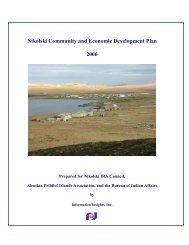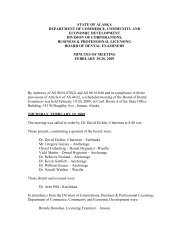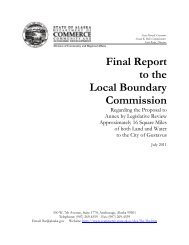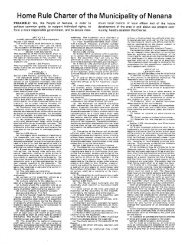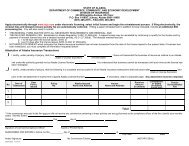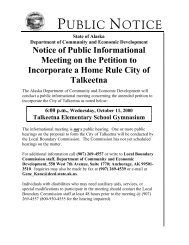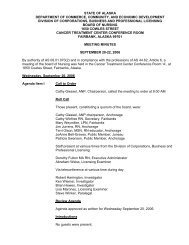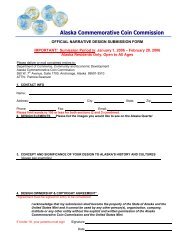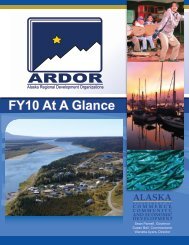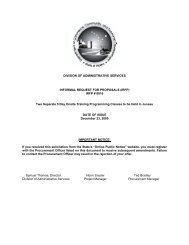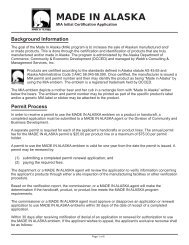Insurance Handbook - Alaska Department of Community and ...
Insurance Handbook - Alaska Department of Community and ...
Insurance Handbook - Alaska Department of Community and ...
You also want an ePaper? Increase the reach of your titles
YUMPU automatically turns print PDFs into web optimized ePapers that Google loves.
<strong>Insurance</strong> Topics Updates at www.iii.org/issues_updates<br />
Flood Auto <strong>Insurance</strong><br />
significantly lower premiums homeowners can usually recover the higher construction<br />
costs in less than five years for homes built in a “velocity” zone, where<br />
the structure is likely to be subject to wave damage, <strong>and</strong> in five to 15 years in a<br />
st<strong>and</strong>ard flood zone. The Federal Emergency Management Agency (FEMA) estimates<br />
that buildings constructed to NFIP st<strong>and</strong>ards suffer about 80 percent less<br />
damage annually that those not built in compliance.<br />
How It Works: The NFIP is administered by FEMA, now part <strong>of</strong> the <strong>Department</strong><br />
<strong>of</strong> Homel<strong>and</strong> Security. Flood insurance was initially only available<br />
through insurance agents who dealt directly with the federal program. The<br />
“direct” policy program has been supplemented since 1983 with a private/public<br />
cooperative arrangement, known as “Write Your Own,” through which a pool<br />
<strong>of</strong> insurance companies issue policies <strong>and</strong> adjust flood claims on behalf <strong>of</strong> the<br />
federal government under their own names, charging the same premium as the<br />
direct program. Participating insurers receive an expense allowance for policies<br />
written <strong>and</strong> claims processed. The federal government retains responsibility for<br />
underwriting losses. Today, most policies are issued through the Write-Your-<br />
Own program but some nonfederally backed coverage is available from the private<br />
market.<br />
The NFIP is expected to be self-supporting (i.e., premiums are set at an<br />
actuarially sound level) in an average loss year, as reflected in past experience.<br />
In an extraordinary year, as Hurricane Katrina demonstrated, losses can greatly<br />
exceed premiums, leaving the NFIP with a huge debt to the U.S. Treasury that it<br />
is unlikely to be able to pay back. Hurricane Katrina losses <strong>and</strong> the percentage <strong>of</strong><br />
flood damage that was uninsured led to calls for a revamping <strong>of</strong> the entire flood<br />
program.<br />
As with other types <strong>of</strong> insurance, rates for flood insurance are based on the<br />
degree <strong>of</strong> risk. FEMA assesses flood risk for all the participating communities,<br />
resulting in the publication <strong>of</strong> thous<strong>and</strong>s <strong>of</strong> individual flood rate maps. Highrisk<br />
areas are known as Special Flood Hazard Areas, or SFHAs.<br />
Flood plain maps are redrawn periodically, removing some properties previously<br />
designated as high hazard <strong>and</strong> adding new ones. New technology enables<br />
flood mitigation programs to more accurately pinpoint areas vulnerable to<br />
flooding. As development in <strong>and</strong> around flood plains increases, run <strong>of</strong>f patterns<br />
can change, causing flooding in areas that were formerly not considered high<br />
risk <strong>and</strong> vice versa.<br />
People tend to underestimate the risk <strong>of</strong> flooding. The highest-risk areas<br />
(Zone A) have an annual flood risk <strong>of</strong> 1 percent <strong>and</strong> a 26 percent chance <strong>of</strong><br />
flooding over the lifetime <strong>of</strong> a 30-year mortgage, compared with a 9 percent risk<br />
48 I.I.I. <strong>Insurance</strong> <strong>H<strong>and</strong>book</strong> www.iii.org/insuranceh<strong>and</strong>book



